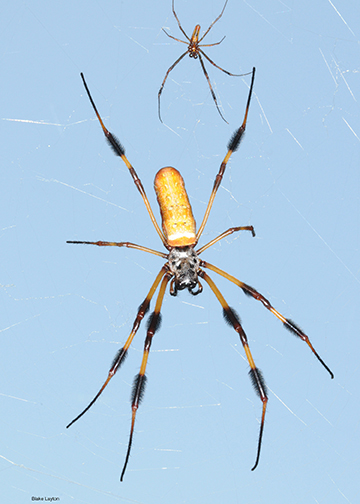Golden Silk Spider, Vol. 3, No. 31

Nephila clavipes
Order: Araneae
Family: Nephilidae
Also known colloquially as “banana spiders,” golden silk spiders seem to be more numerous than usual this year, especially in the southern part of the state. They are called golden silk spiders because the strong silk threads they use to build their webs are gold colored. In fact, people have even used the silk of a closely related species from Madagascar, Nephila inaurata madagascariensis, to weave beautiful, naturally gold-colored spider silk cloth. You can see an example of what has to be one of the most costly pieces of cloth ever made here: ( https://www.wired.com/2009/09/spider-silk/ ). To my knowledge, no one has yet tried making cloth with the species we have here.
Golden silk spiders have expanded their range in the state in recent years, appearing in more and more places where they did not previously occur, and many people are somewhat dismayed to see such large, unusual-looking spiders in the landscape and around the house, especially when there are a lot of them. In some years and locations one can see dozens of large female spiders in a single oak tree or in the trees and shrubs around the edge of the lawn. This range expansion/population explosion seems to be more common following milder winters.
The males are only about 1/10th as big as the females, and can be spotted hanging out around the periphery of the web (see photo). Like many other spiders, golden silk spiders spread locally by ballooning, which occurs when newly hatched spiderlings extend a length of silk into the air and allow the wind to carry them to a new location. However, they can also be easily spread longer distances when immature spiders, adults, or egg sacs are transported on equipment, vehicles or plants. Although golden silk spiders can bite, they are not aggressive, and the bite is not seriously venomous.
Control: Many people view golden silk spiders more as miniature wildlife than as pests and enjoy having them in the yard to observe. But other folks are less tolerant, and there are times when there are just too many spiders, or they have built their web in the wrong place and need to be controlled. They can be killed by spraying directly with an aerosol wasp and hornet spray or other properly labeled insecticide. Alternatively, unwanted spiders can be swiped onto a broom and relocated. Of course, physical control, via the application of blunt force trauma, will also work, but you may need something a bit larger than a fly swatter for most effective control.
Blake Layton, Extension Entomology Specialist, Mississippi State University Extension Service.
The information given here is for educational purposes only. Always read and follow current label directions. Specific commercial products are mentioned as examples only and reference to specific products or trade names is made with the understanding that no discrimination is intended to other products that may also be suitable and appropriately labeled.
